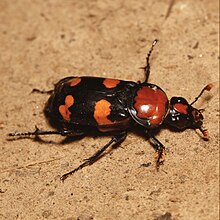This article needs additional citations for verification. (September 2011) |
| Burying beetle Temporal range:
| |
|---|---|

| |
| American burying beetle (Nicrophorus americanus) | |
| Scientific classification | |
| Domain: | Eukaryota |
| Kingdom: | Animalia |
| Phylum: | Arthropoda |
| Class: | Insecta |
| Order: | Coleoptera |
| Family: | Silphidae |
| Subfamily: | Nicrophorinae |
| Tribe: | Nicrophorini |
| Genus: | Nicrophorus Fabricius, 1775 |
| Type species | |
| Silpha vespillo | |
| Synonyms[1] | |
|
List
| |
Burying beetles or sexton beetles, genus Nicrophorus, are the best-known members of the family Silphidae (carrion beetles). Most of these beetles are black with red markings on the elytra (forewings). Burying beetles are true to their name—they bury the carcasses of small vertebrates such as birds and rodents as a food source for their larvae; this makes them carnivorous.[2] They are unusual among insects in that both the male and female parents take care of the brood.[3]
The genus name is sometimes spelled Necrophorus in older texts: this was an unjustified emendation by Carl Peter Thunberg (1789) of Fabricius's original name, and is not valid under the ICZN.
The American burying beetle (Nicrophorus americanus) has been on the U.S. endangered species list since 1989. This species was native to 35 U.S. states but now is only known to exist in 9.[4]
- ^ GBIF: Nicrophorus Fabricius, 1775 (retrieved 13 January 2020)
- ^ Scott, Michelle Pellissier (January 1998). "The Ecology and Behavior of Burying Beetles". Annual Review of Entomology. 43 (1): 595–618. doi:10.1146/annurev.ento.43.1.595. ISSN 0066-4170. PMID 15012399.
- ^ Trumbo, Stephen T. (1990). "Reproductive Benefits of Infanticide in a Biparental Burying Beetle Nicrophorus orbicollis". Behavioral Ecology and Sociobiology. 27 (4): 269–273. doi:10.1007/BF00164899. ISSN 0340-5443. JSTOR 4600477.
- ^ "Federal Register :: Endangered and Threatened Wildlife and Plants; Reclassification of the American Burying Beetle From Endangered to Threatened With a Section 4(d) Rule". 15 October 2020.